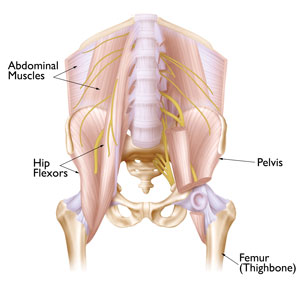Hip Strains
A hip strain occurs when one of the muscles supporting the
hip joint is stretched beyond its limit or torn. Strains may be mild, moderate, or severe, depending on the extent of the injury. A severe strain can limit your ability to move your hip. Anyone can experience a hip strain just doing everyday tasks, but strains most often occur during sports activities. Although many hip strains improve with simple home treatment, severe strains may require physical therapy or other medical treatment.
Description

The large bones that make up the hip joint—the femur (thighbone) and the pelvis—serve as anchors for several muscles. Some of these muscles move across the abdomen or the buttocks (hip flexors, gluteals). Others move down the thigh to the knee (abductors, adductors, quadriceps, hamstrings). In a hip strain, muscles and tendons may be injured. Tendons are the tough, fibrous tissues that connect muscles to bones. Hip strains frequently occur near the point where the muscle joins the connective tissue of the tendon.
The strain may be a simple stretch in your muscle or tendon, or it may be a partial or complete tear of muscle fibers or of the muscle and tendon combination.
Cause
A hip strain can be an acute injury—meaning that it occurs suddenly, such as from a fall or a direct blow during contact sports. Hip strains are also caused by overuse—when the muscle or tendon has slowly become weakened over time by repetitive movements.
Factors that put you at greater risk for a hip strain include:
> Prior injury in the same area
> Muscle tightness
> Failure to warm up properly before exercising
> Attempting to do too much, too quickly, when you exercise
Symptoms
A muscle strain causes pain and tenderness in the injured area. Other symptoms may include:
> Increased pain when you use the muscle
> Swelling
> Limited range of motion
> Muscle weakness
Treatment
Medical treatment for muscle strains is designed to relieve pain and restore range of motion and strength. The majority of hip strains are treated nonsurgically. In addition to the RICE method and anti-inflammatory medication, your doctor may recommend using crutches for a few days to limit the weight on your hip.
**
Call the office of Dr. Darren Keiser to set up an appointment
Article URL: http://orthoinfo.aaos.org/topic.cfm?topic=A00361&webid=2FDDE053
 The large bones that make up the hip joint—the femur (thighbone) and the pelvis—serve as anchors for several muscles. Some of these muscles move across the abdomen or the buttocks (hip flexors, gluteals). Others move down the thigh to the knee (abductors, adductors, quadriceps, hamstrings). In a hip strain, muscles and tendons may be injured. Tendons are the tough, fibrous tissues that connect muscles to bones. Hip strains frequently occur near the point where the muscle joins the connective tissue of the tendon.
The strain may be a simple stretch in your muscle or tendon, or it may be a partial or complete tear of muscle fibers or of the muscle and tendon combination.
The large bones that make up the hip joint—the femur (thighbone) and the pelvis—serve as anchors for several muscles. Some of these muscles move across the abdomen or the buttocks (hip flexors, gluteals). Others move down the thigh to the knee (abductors, adductors, quadriceps, hamstrings). In a hip strain, muscles and tendons may be injured. Tendons are the tough, fibrous tissues that connect muscles to bones. Hip strains frequently occur near the point where the muscle joins the connective tissue of the tendon.
The strain may be a simple stretch in your muscle or tendon, or it may be a partial or complete tear of muscle fibers or of the muscle and tendon combination.

